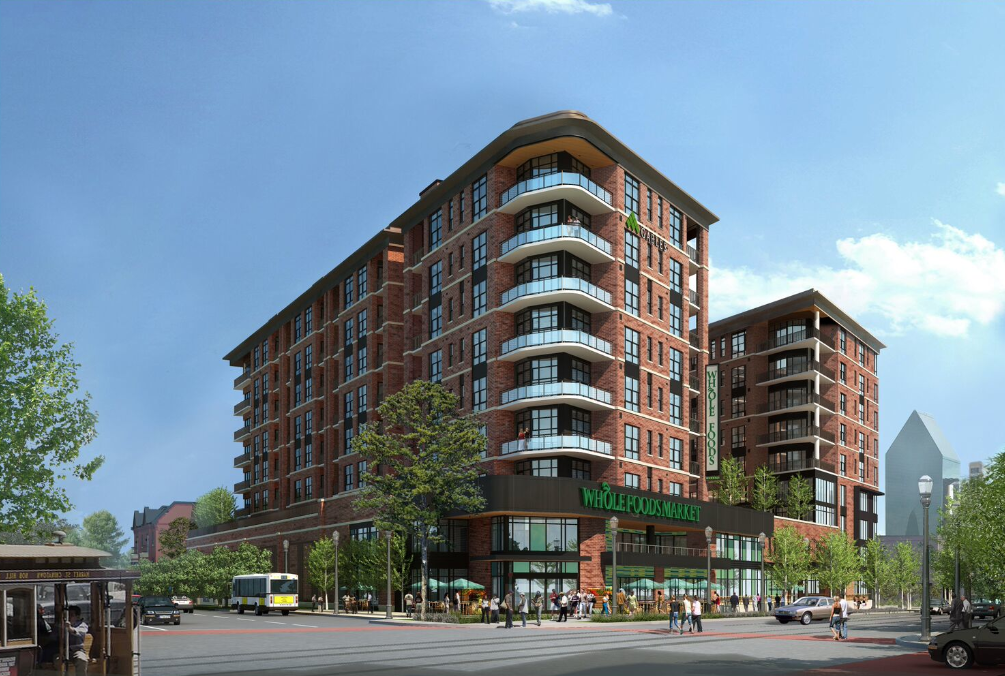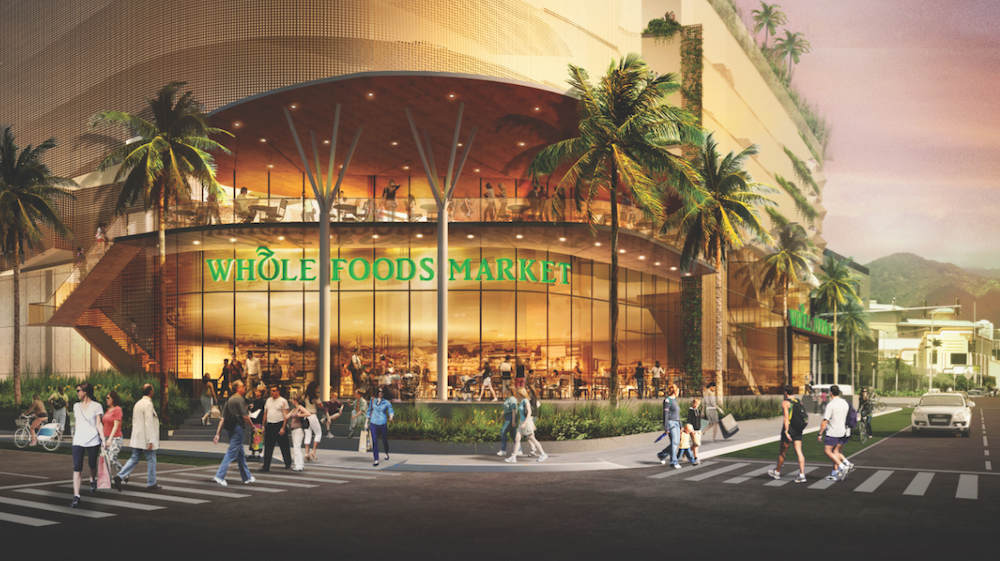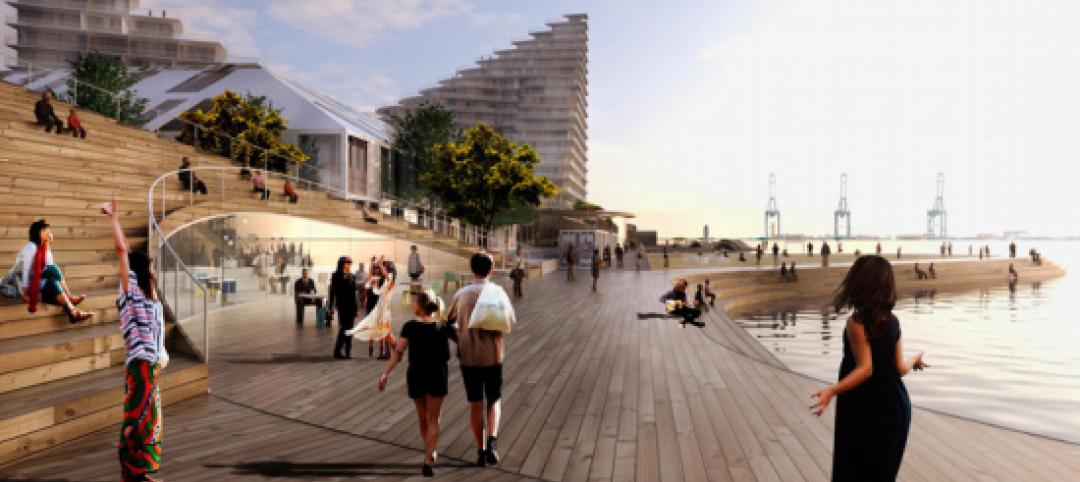In July, the Howard Hughes Corporation began selling condos in Ae’o, one of five residential towers that the developer is building within its 60-acre master planned Ward Village on the Hawaiian island of Oahu.
When it’s completed sometime in 2018, the Bohlin Cywinski Jackson-designed Ae’o will have 466 residences that range from 409 to 1,331 sf and start in the low $400s. At the base of that tower will be a 50,000-sf Whole Foods Market.
Supermarkets have always been sought-after—and, some would argue, essential—tenants for mixed-use projects, especially for those in urban areas where grocery stores have become harder to come by.
In Boston, Millennium Tower at Downtown Crossing, a 60-story luxury high rise with 442 units, is scheduled to open in the summer of 2016 next to a new 37,000-sf Roche Bros. gourmet supermarket. In Newark, N.J., a former 440,000-sf Hahne Department Store is currently under reconstruction by L+M Development and Hanini Group as a building with 160 mixed-income apartments and a 29,000-sf Whole Foods on the ground floor. And Extell Development has promised the community to include an affordable supermarket as part of the retail component of its Two Bridges tower project in Manhattan, which is being built on land where a Pathmark supermarket was closed to make way for the residential buildings. Lend Lease is the construction manager on this project.
 Whole Foods within Eighth & Grand in Los Angeles, image courtesy Carmel Partners
Whole Foods within Eighth & Grand in Los Angeles, image courtesy Carmel Partners
Carmel Partners’ Eighth & Grand, a 700-unit mixed-use community designed by Commune, is currently preleasing and should open later this year. The ground floor of this three-acre site features the first Whole Foods Market to open in downtown Los Angeles. And in Dallas’s Uptown neighborhood, Gables Residential has had a waiting list since September 2014 for the 222 apartments and 17 townhomes in its eight-story Gables McKinney Avenue building, which sits atop a Whole Foods that opened on August 12. The urbanized supermarket includes a coffee and smoothie bar, a café, and a taproom with 24 taps for beer, wine, and cold-brew coffee.
Whole Foods Market, with 408 stores in the U.S., has operated in Hawaii for seven years and currently has four stores in the state. The Oahu location will be the retail supermarket’s first on that island and its flagship in Honolulu.
“Our focus is to bring in the best retailers for the daily needs” of residents and the local community, says Nick Vanderboom, Senior Vice President of Development at Ward Village. One of the other towers that Hughes is planning for Ward Village—988 Halekauwila, with 424 for-sale units, which opens in 2019—will include a 23,000-sf full-service Long’s Drugs at street level.
Ward Village on Oahu is designed to be Hawaii’s first LEED Platinum ND-certified development. Vanderboom acknowledges that the decision to include a supermarket in a residential tower “always complicates the design.” Sanitation and logistical issues must be addressed. As for parking, Hughes decided to put the lot for the supermarket and other retail within the tower above the stores, and have a separate area for resident parking.
This is a combination that Hughes likes elsewhere, too. Vanderboom says the developer has two stateside mixed-used projects that include Whole Foods: in Columbia, Md., a $25 million adaptive reuse of the 89,000-sf Rouse Company’s headquarters; and new construction in The Woodlands in Houston, where the supermarket will be next to the apartment tower and other retail.
 Whole Foods at the base of the Gables McKinney Avenue building in Dallas, image courtesy Gables Residential
Whole Foods at the base of the Gables McKinney Avenue building in Dallas, image courtesy Gables Residential
Related Stories
| Oct 27, 2014
Report estimates 1.2 million people experience LEED-certified retail centers daily
The "LEED In Motion: Retail" report includes USGBC’s conceptualization of the future of retail, emphasizing the economic and social benefit of green building for retailers of all sizes and types.
| Oct 16, 2014
Perkins+Will white paper examines alternatives to flame retardant building materials
The white paper includes a list of 193 flame retardants, including 29 discovered in building and household products, 50 found in the indoor environment, and 33 in human blood, milk, and tissues.
| Oct 15, 2014
Harvard launches ‘design-centric’ center for green buildings and cities
The impetus behind Harvard's Center for Green Buildings and Cities is what the design school’s dean, Mohsen Mostafavi, describes as a “rapidly urbanizing global economy,” in which cities are building new structures “on a massive scale.”
| Oct 12, 2014
AIA 2030 commitment: Five years on, are we any closer to net-zero?
This year marks the fifth anniversary of the American Institute of Architects’ effort to have architecture firms voluntarily pledge net-zero energy design for all their buildings by 2030.
| Sep 25, 2014
Bjarke Ingels headed home for latest project: Aarhus Island
Aarhus Island will be a waterside development in Denmark's second-largest city. The mixed-use development will implement Ingels' signature angled look in its residential towers.
| Sep 24, 2014
Architecture billings see continued strength, led by institutional sector
On the heels of recording its strongest pace of growth since 2007, there continues to be an increasing level of demand for design services signaled in the latest Architecture Billings Index.
| Sep 22, 2014
4 keys to effective post-occupancy evaluations
Perkins+Will's Janice Barnes covers the four steps that designers should take to create POEs that provide design direction and measure design effectiveness.
| Sep 22, 2014
Sound selections: 12 great choices for ceilings and acoustical walls
From metal mesh panels to concealed-suspension ceilings, here's our roundup of the latest acoustical ceiling and wall products.
| Sep 15, 2014
Ranked: Top international AEC firms [2014 Giants 300 Report]
Parsons Brinckerhoff, Gensler, and Jacobs top BD+C's rankings of U.S.-based design and construction firms with the most revenue from international projects, as reported in the 2014 Giants 300 Report.
| Sep 9, 2014
Using Facebook to transform workplace design
As part of our ongoing studies of how building design influences human behavior in today’s social media-driven world, HOK’s workplace strategists had an idea: Leverage the power of social media to collect data about how people feel about their workplaces and the type of spaces they need to succeed.















